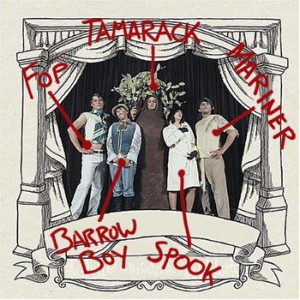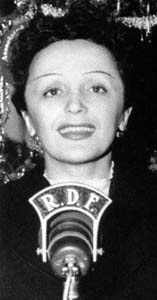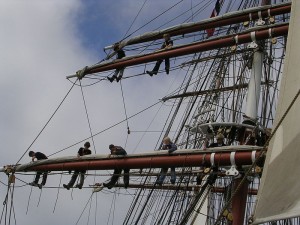The Annotated Decemberists No. 3: “My Mother Was a Chinese Trapeze Artist”
 Perhaps no band’s lyrics better lend themselves to pseudo-academic analysis than those of The Decemberists. The Annotated Decemberists is an attempt to puzzle through the Portland, Oregon, group’s entire catalog song by song—examining all the obscure vocabulary, historical references and poetic subtext—or go crazy trying.
Perhaps no band’s lyrics better lend themselves to pseudo-academic analysis than those of The Decemberists. The Annotated Decemberists is an attempt to puzzle through the Portland, Oregon, group’s entire catalog song by song—examining all the obscure vocabulary, historical references and poetic subtext—or go crazy trying.
This is the song that started it all. In 1999, Colin Meloy was a recent graduate of the University of Montana whose alt-country band, Tarkio, was quickly coming to the end of its run. As related to Sean Nelson for a detailed article in the Seattle alt-weekly paper The Stranger, “My Mother Was a Chinese Trapeze Artist” was inspired by a particularly awful family canoe trip:
“It was this super, super intense, three-day river trip where we were all just stuck together and it was all just like one constant fight, and everybody was angry at each other for all different reasons.
“I came off that trip with this loathing for my family, and I wrote a song about basically completely re-creating the family in this really fantastical setting, using myself as this sort of sad anti-hero.”
Meloy wrote the song as a lark, with no goal in mind other than to make his girlfriend laugh, but it marked a new style of songwriting, full of what would become Decemberists trademarks: fanciful language, vagabond characters and historical references. Tarkio recorded a version, but Meloy continued to play it after moving to Portland and meeting local musicians Jenny Conlee and Nate Query. The rest, as they say, is romanticized history.
“My Mother Was a Chinese Trapeze Artist”
From 5 Songs (2001, re-released 2003)

My mother was a Chinese trapeze artist[1]
In pre-war Paris
Smuggling bombs for the underground.
And she met my father
At a fete[2] in Aix-en-Provence[3].
He was disguised as a Russian cadet
in the employ of the Axis[4].
And there in the half-light[5]
Of the provincial midnight
To a lone concertina[6]
They drank in cantinas
And toasted to Edith Piaf[7]
And the fall of the Reich.
My sister was born in a hovel[8] in Burgundy[9]
And left for the cattle
But later was found by a communist
Who’d deserted his ranks
To follow his dream
To start up a punk rock band in South Carolina[10].
I get letters sometimes.
They bought a plantation
She weeds the tobacco
He offends the nation
And they write, “Don’t be a stranger, y’hear.”
“Sincerely, your sister.”

So my parents had me
To the disgust of the prostitutes
On a bed in a brothel[11].
Surprisingly raised with tender care
‘Til the money got tight
And they bet me away
To a blind brigadier[12] in a game
Of high stakes canasta[13].
But he made me a sailor
On his brigadier ship fleet.
I know every yardarm[14]
From main mast[15] to jib[16] sheet[17].
But sometimes I long to be landlocked
And to work in a bakery.
- Although acrobatics have a long history in Chinese culture, stretching back at least to the Han Dynasty more than 2,000 years ago, the art of trapeze is a modern, French innovation, created in 1859 by Jules Leotard (whose name lives on in the gymwear he popularized).↑
- “n. a festival; entertainment; esp., a gala entertainment held outdoors.”↑
- A city in southern France, about 20 miles north of Marseille.↑
- Now, I know what you’re thinking: “By the time France fell to the Germans in World War II, the Soviet Union was fighting the Nazis, so why would a Russian cadet be in the employ of the Axis Powers?” It turns out that the Russian Cadet Corps—a military academy for young boys—was supportive of the White, pro-Tsarist forces during the Russian Civil War, and several former cadets joined the Russian Corps in World War II, fighting in alliance with the Axis forces in hopes of bringing down the Communist regime … so it all makes perfect sense.↑
- We spent a lot of time talking about the term “half-light” and its literary implications in the previous entry in this series.↑
- “n. a musical instrument similar to an accordion but smaller and with buttons instead of a keyboard.”↑
- Legendary French singer, who was already the most popular entertainer in the country before the war and went on to international fame afterward.↑
- “n. 1 a low, open shed as for sheltering animals or storing supplies or equipment 2 any small, miserable dwelling; hut.” Considering the next sentence, it seems that the hero’s sister was born in a literal hovel.↑
- Historically, Burgundy was a large region encompassing parts of modern-day France and Switzerland, named after a Germanic tribe that had originated in Sweden and settled in the area in the 5th century as the western Roman Empire was busy crumbling. Today Burgundy is a administrative region in eastern France. Its chief city is Dijon, about 160 miles southeast of Paris.↑
- An apparent anachronism, although it is possible that the sister was born after World War II and “found” by this communist when she was in her mid-20s and punk rock was first being developed.↑
- Another possible homage to Piaf, who spent much of her childhood in a brothel run by her grandmother.↑
- A military rank indicating an officer in charge of a brigade (about 3,000 troops). It is generally an army rank and not used in the navy, so most brigadiers wouldn’t have a fleet. This is obviously an exception. Maybe the navy felt bad because he was blind and gave him some ships.↑
- A card game in the rummy family of games, which are characterized by players matching similar cards, generally played with four players in partnerships. According to the card game website pagat.com: “The game of Canasta is said to have originated in Montevideo, Uruguay in 1939. … From there it spread to Argentina, the USA and throughout the world. It was extremely fashionable in the 1950’s, threatening for a while to displace Contract Bridge as the premier card game.” It also has a rather funny name.↑
- A nautical term for the outer tips of a “yard,” a pole (or “spar”) used to support a sail. A yard generally describes the horizontal spars attached to a tall ship’s mast for setting square sails.↑
- The tallest vertical spar, usually located in the center of the ship.↑
- A smaller, triangular sail at the front of a ship, attached to the supportive guy-wire (or “stay”) running from the bow to the foremost mast.↑
- A controlling rope (which sailors insist on calling a “line”) used to adjust the angle of the jib.↑